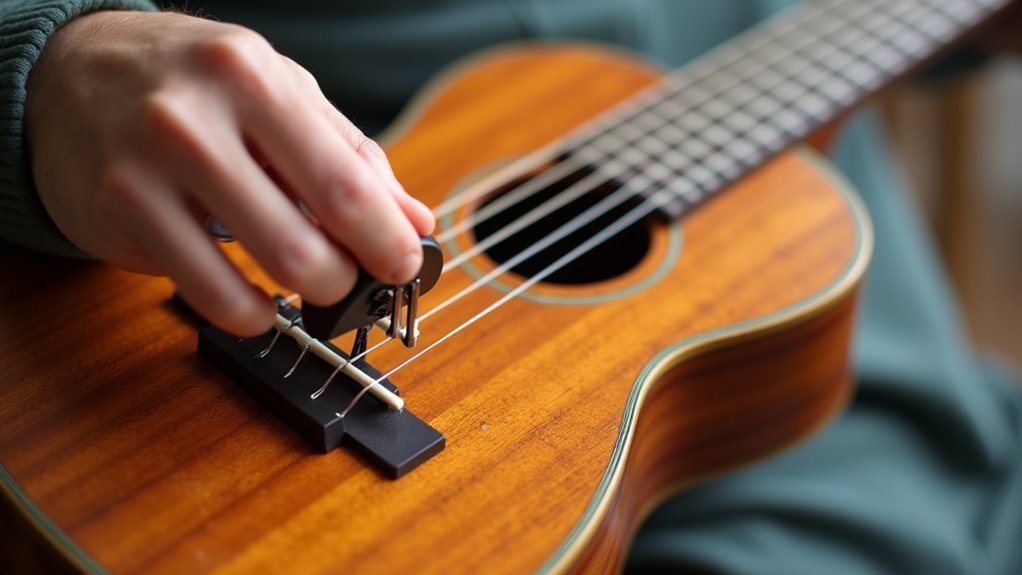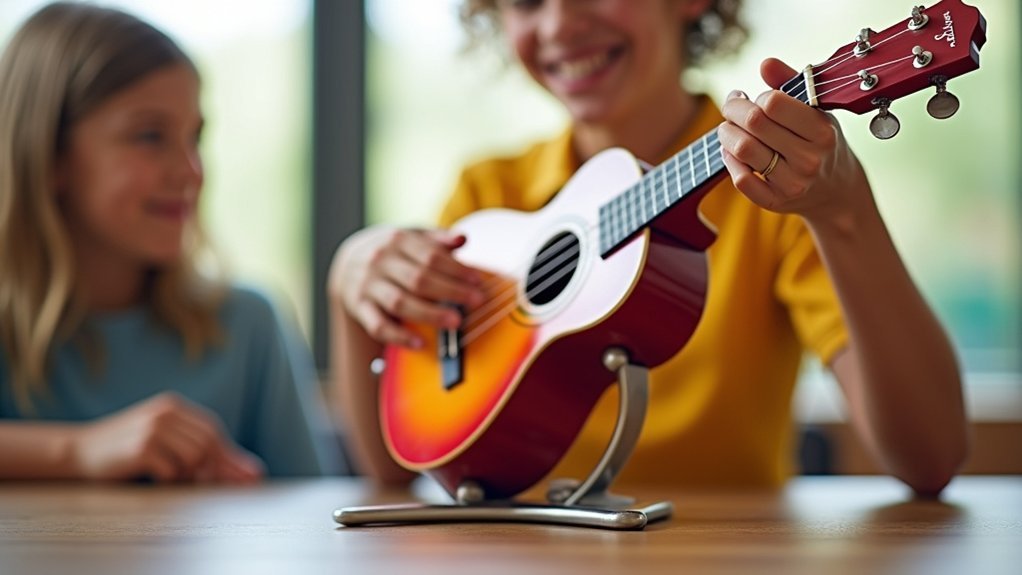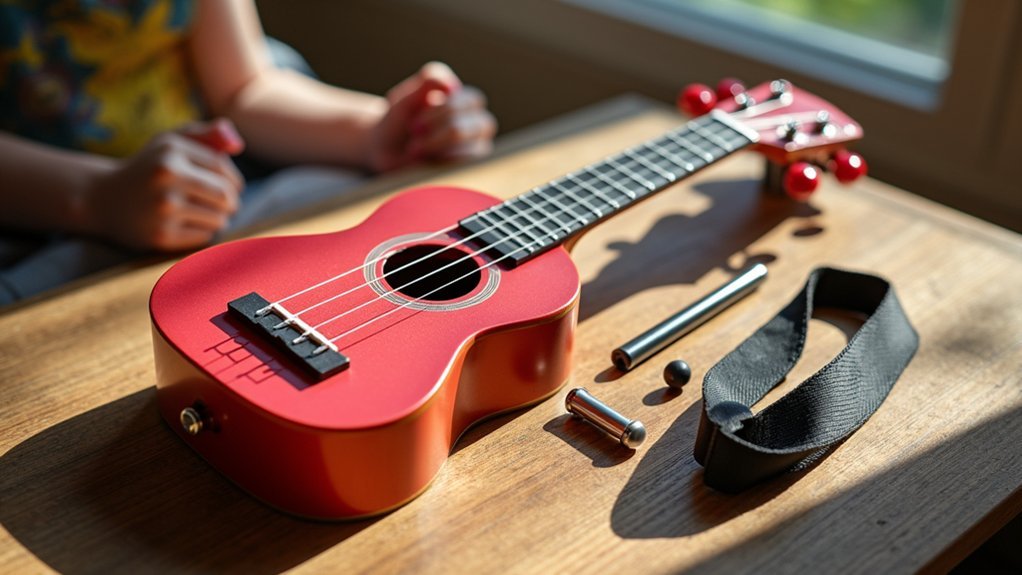Ukulele adaptations empower players with disabilities through affordable innovations like the $10 Strum Buddy for foot/knee-controlled strumming and specialized felt picks for easier sound production. You’ll find simplified one-finger chord techniques, customizable mounting systems, and digital assistive technologies offering visual guides and audio feedback. DIY options using everyday materials like rubber bands and backpack straps make personalized solutions accessible. Communities like the Ukulele Kids Club connect musicians facing similar challenges, proving music remains within everyone’s reach.
Custom Strumming Devices for One-Handed Players

While traditional ukulele playing requires both hands, innovative custom strumming devices have opened musical doors for one-handed players. The Ukulele Strum Buddy exemplifies this innovation, allowing you to control a pick using your foot or knee while focusing on chord work with your available hand.
One-handed musicians find freedom through adaptive technology, proving disability need not silence musical expression.
For those with upper arm disabilities, the Ukulele Support System offers specialized adaptations including arm splints and chord changers. These tools have proven valuable in music therapy settings, where participation builds confidence and motor skills.
Inspired by musician Lefty Williams’ prosthesis, newer devices provide effective strumming solutions for players missing limbs. Tavit Smith designed the Strum Buddy to be built at home for under $10, making adaptive music accessible across socioeconomic backgrounds.
User feedback continuously improves these designs, ensuring they meet real needs.
Alternative Chord Fingering Techniques for Limited Dexterity
Despite common perceptions that ukulele playing requires full dexterity, players with limited finger mobility can access a range of simplified chord shapes that maintain musical integrity.
If you’re among people with upper arm challenges, try one-finger chords like C, C7, Am, and A7 that require minimal movement.
You’ll find Fadd9 (0010) and simplified D7 particularly helpful as they demand less complex positioning.
Single-finger variations such as G6 and Fadd2 can replace traditional shapes, allowing you to play comfortably while preserving musical quality.
Consider two-finger chord adaptations to further expand your repertoire.
Additionally, exploring alternative tunings—especially open tunings—can reduce string tension and simplify fingerings.
These adjustments make the ukulele more accessible without compromising your ability to create beautiful music.
Ukulele Mounting Systems and Supportive Stands

For players with upper arm disabilities, specialized mounting systems transform the ukulele from an inaccessible instrument into a viable musical outlet. The Ukulele Support System features adjustable cradles and arm splints with styluses, allowing you to hold and strum effectively despite physical limitations.
- Personalized adaptive tools can be tailored to your specific needs, enhancing accessibility.
- Chord changers from companies like Troubadour can be integrated to simplify shifts.
- Adjustable cradles provide stable positioning without requiring upper arm strength.
- Community initiatives like Ukulele Kids Club promote these adaptive technologies.
You’ll find these ukulele mounting systems particularly beneficial if you’re facing upper arm disabilities. They’re designed with your unique challenges in mind, ensuring that physical limitations don’t prevent you from experiencing the joy of making music.
Specialized Picks and Strumming Tools
Mounting systems provide stability for the ukulele, but specialized picks and strumming tools address another key challenge for players with disabilities: how to actually produce sound from the instrument.
You’ll find innovative options like the Ukulele Strum Buddy, which allows you to attach specialized picks to adaptive devices controlled by your foot or knee when hand dexterity is limited.
The Ukulele Support System offers custom adaptations including arm splints with styluses, enabling effective strumming for those with upper arm disabilities.
The Ukulele Support System’s innovative arm splints and styluses empower musicians with upper arm disabilities to express themselves through strumming.
Felt picks provide an easier strumming option if you struggle with traditional picks. Many adaptive tools also feature adjustable pick angles to accommodate your unique playing style.
Tools like the Chordmaster simplify chord playing, letting you focus on musical expression rather than complex finger positioning.
Modified Tuning Approaches for Simplified Playing

While traditional ukulele techniques can present challenges, modified tuning approaches offer game-changing possibilities for players with disabilities. You can adjust your ukulele’s tuning to create more accessible finger placements that accommodate your specific needs. Open tunings, like tuning to a C major chord (C-G-C-E), allow you to play by simply strumming without pressing any frets.
- Lowering string tension through alternate tunings reduces physical strain for players with special needs.
- Simplified chord shapes require fewer fingers or even single-finger techniques.
- Using a capo maintains easier chord formations while changing the instrument’s pitch.
- Open tunings enable chord production by strumming open strings without fretting.
These modifications transform the playing experience by working with your body’s capabilities rather than against them, making music-making more inclusive and enjoyable.
Adaptive Straps and Holding Mechanisms
Three key innovations in adaptive straps and holding mechanisms have revolutionized ukulele accessibility for players with disabilities. These adaptations distribute weight evenly, reducing strain while ensuring you can comfortably play for extended periods. The Ukulele Support System offers custom cradles and arm splints that enable playing despite physical challenges.
| Adaptation | Benefit | Best For |
|---|---|---|
| Adaptive straps | Secures instrument in position | Limited mobility |
| Support cradles | Distributes weight evenly | Upper arm disabilities |
| Ukulele Strum Buddy | Allows foot/knee control | Limited arm function |
| Adjustable holding mechanisms | Personalized positioning | Various playing needs |
You’ll find these solutions particularly helpful if you struggle with traditional holding positions. With these adaptations, you can focus on making music rather than struggling to maintain proper instrument position.
Digital Assistive Technologies for Ukulele Learning
Digital tools like chord learning apps provide customizable interfaces that display finger placements specifically adapted for your unique abilities.
Virtual finger placement technologies use augmented reality to project chord positions directly onto your ukulele, eliminating the need to constantly reference printed materials.
Wearable strumming aids, such as finger-mounted sensors that connect to your smartphone, can track your progress and offer real-time feedback tailored to your physical capabilities.
Chord Learning Apps
For players with disabilities, chord learning apps represent a significant advancement in accessible ukulele instruction. These tools make music more accessible through customizable interfaces that adapt to your specific needs. A digital chord changer feature allows you to visualize different finger positions without straining your hands.
You’ll find these apps particularly helpful because they:
- Provide visual diagrams that simplify chord shapes, making it easier to play the ukulele with limited dexterity
- Include audio playback so you can hear correct chord sounds while learning
- Offer adjustable settings like alternative tunings to accommodate physical limitations
- Feature gamification elements that keep learning engaging and motivational
Many apps also connect you with supportive communities where you can share progress and learn from others facing similar challenges.
Virtual Finger Placement
Virtual finger placement technology takes chord learning to the next level by creating an interactive visual experience for ukulele players with disabilities.
These assistive technologies allow you to visualize chord shapes and practice finger positions on touchscreens, providing real-time feedback to improve your technique despite upper mobility challenges.
You’ll benefit from customizable settings that offer simplified chord shapes and alternate tunings, making the ukulele more accessible if you have limited dexterity.
Many platforms include tailored tutorials that accommodate your specific physical needs while building your confidence and skills.
Beyond individual practice, these virtual tools connect you with a community of players facing similar challenges.
Wearable Strumming Aids
Wearable strumming aids represent a revolutionary breakthrough for ukulele players with limited upper body mobility or hand dexterity. Innovations like the Ukulele Strum Buddy let you control a pick using your foot or knee, creating new pathways to musical expression if you’re living with upper arm disabilities.
Deb Guarneiri’s Ukulele Support System and Tavit Smith’s affordable designs (under $10) have made these adaptations increasingly accessible:
- Custom cradles and arm splints with styluses enable participation despite mobility challenges
- Adjustable pick angles accommodate your personal strumming technique
- Affordable construction using materials available in developing countries
- Community feedback mechanisms guarantee continuous improvement
The impact extends beyond individual players, with organizations like the Ukulele Kids Club demonstrating how these aids facilitate music therapy and social engagement for children with disabilities.
Single-Finger Chord Progressions and Song Adaptations
When traditional chord formations present barriers to playing, single-finger chord progressions offer an elegant solution for ukulele players with disabilities. Simple shapes like C (0003), C7 (0001), and Am (2000) require just one finger placement, making them accessible when dexterity is limited.
Any music teacher will confirm that these adaptations enable more players to be able to play without frustration.
Try incorporating creative options like Fadd9 (0010) and A7 (0200) to expand your musical possibilities. For beginners, focus on nursery rhymes using simplified progressions of C, Fadd2, and G7sus2.
These foundations work well with down-strum-only patterns, helping you maintain steady rhythm despite mobility challenges. You’ll quickly build confidence as you master these adaptations, experiencing the joy of making music on your own terms.
Community Resources for Adaptive Ukulele Players
Finding support through established organizations can transform your ukulele journey if you’re facing physical challenges. The Ukulele Kids Club now reaches 237 hospitals globally, offering music therapy and instruments to thousands of children with disabilities.
- Tavit Smith’s Ukulele Strum Buddy helps one-armed players control picks using foot or knee movements.
- Deb Guarneiri’s Support System includes arm splints and cradles for those with upper limb limitations.
- Community jam sessions create inclusive environments for players of all abilities, including Wounded Warriors.
- Collaborative networks between organizations facilitate sharing of adaptive techniques and affordable solutions.
These resources foster both musical development and emotional wellbeing, connecting you with a supportive community that understands the importance of adaptive solutions in making music accessible to everyone regardless of physical limitations.
DIY Adaptations Using Everyday Materials
Creating your own ukulele adaptations doesn’t require expensive equipment or specialized tools. You can help people with upper limb disabilities play ‘ukulele through simple DIY adaptations using materials found around your home.
Try fashioning strumming aids from rubber bands, tape, and pencils for effective string contact. For players with limited arm mobility, transform backpack straps into a supportive harness that positions the instrument comfortably.
Consider crafting a metal ring attached to a strap that allows strumming with a foot or knee while securely holding a pick. Use a soldering iron to create customized holes in straps and picks for better connections and control.
The Ukulele Strum Buddy exemplifies how inexpensive materials can become effective playing devices for individuals with one functioning arm.
Frequently Asked Questions
What Makes the Ukulele Special?
The ukulele’s special because it’s lightweight, compact, and easy to play. You’ll love its mellow sound, simple chord shapes, and affordable price. It’s incredibly accessible for beginners and creates a joyful musical experience.
What Are the Benefits of Learning Ukulele?
You’ll boost your emotional well-being through creative expression. You’re enhancing cognitive skills like memory and attention. You’ll build social connections, gain confidence, and enjoy a portable instrument that’s accessible regardless of your age or ability.
Why Is the Ukulele Used in Music Education at Many Schools?
Schools use ukuleles because they’re affordable, portable, and easy to learn. You’ll quickly master basic chords, boosting your confidence. They’re accessible for various abilities and develop important musical, cognitive, and social skills.
What Are the Benefits of a Soprano Ukulele?
You’ll enjoy the soprano ukulele’s lightweight design, bright sound, and easy playability. Its small size makes finger positioning simpler, and you’ll find abundant learning resources. It’s perfect for both beginners and experienced players.
In Summary
You’ve discovered that the ukulele offers countless adaptations for players with disabilities. Whether you’re exploring custom strumming devices, alternative chord fingerings, or specialized mounting systems, don’t let physical limitations stop you from making music. Remember, there’s a supportive community ready to help and many DIY solutions using everyday materials. With these tools and techniques, you’ll find your unique way to express yourself through this versatile instrument.





Leave a Reply